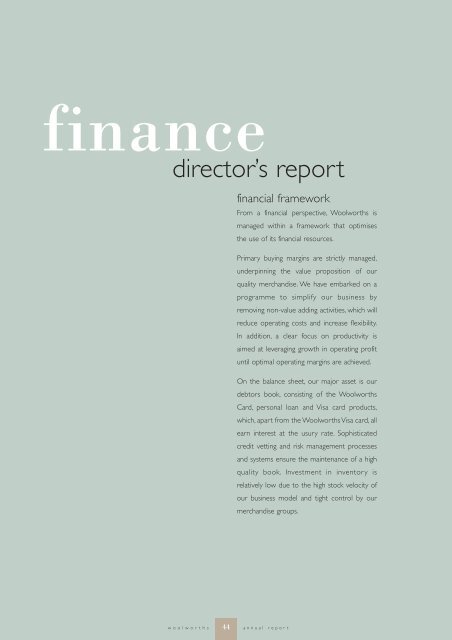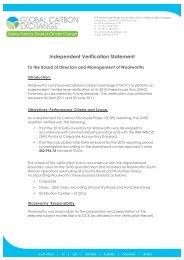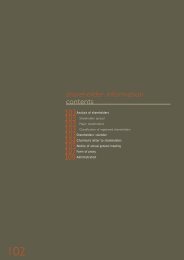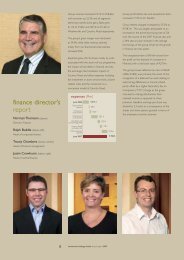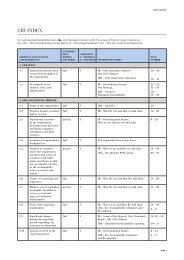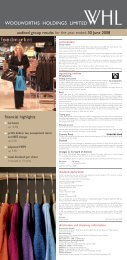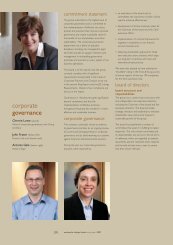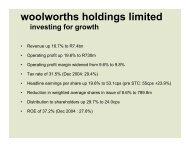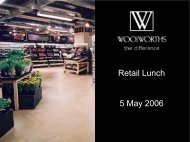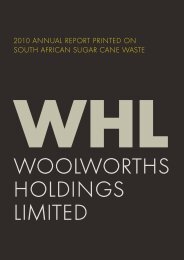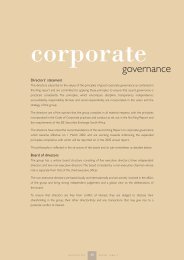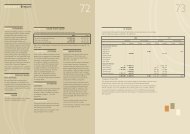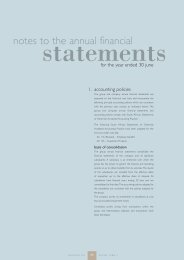director's report - woolworths holdings limited
director's report - woolworths holdings limited
director's report - woolworths holdings limited
You also want an ePaper? Increase the reach of your titles
YUMPU automatically turns print PDFs into web optimized ePapers that Google loves.
finance<br />
director’s <strong>report</strong><br />
financial framework<br />
From a financial perspective, Woolworths is<br />
managed within a framework that optimises<br />
the use of its financial resources.<br />
Primary buying margins are strictly managed,<br />
underpinning the value proposition of our<br />
quality merchandise. We have embarked on a<br />
programme to simplify our business by<br />
removing non-value adding activities, which will<br />
reduce operating costs and increase flexibility.<br />
In addition, a clear focus on productivity is<br />
aimed at leveraging growth in operating profit<br />
until optimal operating margins are achieved.<br />
On the balance sheet, our major asset is our<br />
debtors book, consisting of the Woolworths<br />
Card, personal loan and Visa card products,<br />
which, apart from the Woolworths Visa card, all<br />
earn interest at the usury rate. Sophisticated<br />
credit vetting and risk management processes<br />
and systems ensure the maintenance of a high<br />
quality book. Investment in inventory is<br />
relatively low due to the high stock velocity of<br />
our business model and tight control by our<br />
merchandise groups.<br />
w oolwor t hs<br />
44<br />
annual <strong>report</strong>
Group turnover from continuing operations rose by 24.2% to R8 421,4m. Woolworths grew sales<br />
22.6% in the 53 weeks to June to R7 302,0m, compared to a 52 week period last year, with the impact<br />
of the additional week adding approximately 2.3%. Sales on a comparable store basis increased 15.5%<br />
against last year. Consumer spending in South Africa was positive throughout the period with Textiles<br />
sales for the 53 weeks increasing by 17.7% against last year (12.2% on a comparable store basis) and<br />
Food sales by 28.7% against last year (18.7% on a comparable store basis).<br />
Total trading area in Woolworths grew 4.2% to 333 692m 2 as a result of 13 new store openings, which<br />
added 8 800m 2 . Eight stores, totalling 7 150m 2 ,were converted to the franchise format, which now<br />
accounts for 65 002m 2 of the total trading space.Textiles footage now totals 266 635 m 2 (62 119 m 2<br />
franchise) and Foods footage 67 057m 2 (2 883m 2 franchise).<br />
Country Road’s revenue from continuing operations grew by 3% in Australian dollar terms to<br />
A$207m, but translated into 36% growth in rand terms, to R1 125m. After the closure of the USA<br />
operations, Country Road now trades from 44 stores with a total footage of 23 560m 2 .<br />
Gross profit margin in Woolworths, increased marginally to 31.4%, but fell from 52% to 50% in<br />
Country Road due to increased promotional activity to counter significant discounting among<br />
competitors and an unusually warm winter.<br />
Interest received increased 20.6% to R355,5m. R341,7m was earned by Woolworths Financial<br />
Services, with the Woolworths Card growing in line with sales and the personal loan offering showing<br />
strong growth. Growth in income was constrained by the usury rate, which, for several months in the<br />
second half, failed to keep pace with increases in the prime lending rate.<br />
Operating expenses were well managed during the year growing 17.5% in Woolworths, as a result of<br />
increased trading activity, whilst Country Road’s costs in their continuing operations were 5.9% lower<br />
in Australian dollar terms as a result of head office rationalisation following the closure of the USA<br />
operations. Costs were 22.6% up in rand terms.A large portion of the operating costs in Woolworths<br />
are variable, particularly in the Foods business, and move in line with the increase in<br />
sales volumes.<br />
w oolwor t hs<br />
45<br />
annual <strong>report</strong>
Operating profit from continuing operations increased by 45.8% to R685,2m, Woolworths<br />
contributing R663,1m and Country Road R22,1m, although the latter benefited from second quarter<br />
A$ profits being translated at an exchange rate significantly weaker than the rate at which first quarter<br />
A$ losses were sustained.<br />
Finance costs increased 8% in Woolworths as a result of strict working capital management during<br />
the year and a higher level of cash resources for a large part of the year as a result of property<br />
disposals in December 2001. In Country Road, borrowing costs increased A$0,8m to A$1,1m due to<br />
higher cash flow requirements experienced in the first half of the year.<br />
Net profit before tax and exceptional items, from continuing operations, increased 47.7% to<br />
R599,2m.The exceptional items relate to a R17,2m impairment of the Claremont store property after<br />
having taken the decision to relocate into Cavendish Square; goodwill amortisation of R12,1m arising<br />
mainly from the acquisition of inthebag from Wooltru; a loss of R4,8m on the disposal of a listed<br />
investment and a provision of R7,4m in respect of an indemnity given by the company.<br />
The effective tax rate, from continuing operations before exceptional items, was down from the<br />
previous year at 32.1% (2001: 33.9%) reflecting the benefit of the assessed loss in Country Road,<br />
enhanced by the translation benefit of the rand’s sharp decline.<br />
Discontinued Operations: Country Road’s exit from the USA market resulted in a write off of net<br />
assets amounting to A$18,9m and other costs and provisions of A$5,0m, which translated to R122,6m<br />
after minority interests.<br />
Capital expenditure amounted to R335,0m offset by proceeds on disposals of R146,7m, R108,0m of<br />
which related to the sale of certain non-strategic properties for which long term leases have been<br />
entered into.<br />
Shares issued under the share purchase scheme raised R41,3m, whilst shares totalling R134,7m,<br />
repurchased by a subsidiary company as treasury stock under the shareholders’ authority granted at<br />
last year’s annual general meeting, were repurchased at an average price of R4,05 per share.<br />
finance direc<br />
w oolwor t hs<br />
46<br />
annual <strong>report</strong>
Total assets increased by 8.9% to R4 063,8m,<br />
mainly attributable to the growth in the<br />
debtors book, whilst net capital expenditure<br />
was largely in line with the depreciation charge.<br />
The R131,6m write-off resulting from the<br />
closure of Country Road’s USA operations was<br />
substantially offset by the R87,4m increase in<br />
the value of the remaining assets of Country<br />
Road on translation.<br />
The debtors book, comprising card and<br />
personal loan products, and including our<br />
funding of the Woolworths Visa Card Joint<br />
Venture with Mercantile Bank grew by<br />
R364,8m and now totals R1 800,5m. Bad debt<br />
levels continued to be well managed during the<br />
year and improved recoveries led to a net bad<br />
debt level of 2.7%.The doubtful debt provision<br />
remains conservatively calculated.<br />
the state in taxes, 2.1% to lenders, 7% to<br />
shareholders, and 22.0% was retained in the<br />
business.<br />
The debt:equity ratio of 15.8%, which was<br />
exaggerated as a result of the 53rd week net<br />
cash outflows, reflects the strong balance sheet<br />
position of the group. Return on equity, based<br />
on attributable earnings from continuing<br />
operations, improved to 17.2% from 13.5% last<br />
year, indicating the effect of the improved<br />
trading result on a leaner balance sheet.<br />
Looking forward our goal is to continually<br />
improve the return on our shareholders’ funds<br />
within the group’s financial framework.<br />
Banking facilities totalling R1 549,3m, are<br />
available to the group which greatly exceeds<br />
our estimated peak funding requirements.<br />
Interest rates and foreign exchange exposures<br />
are managed within strict treasury policy<br />
guidelines. At the end of the year, R150m of<br />
short-term borrowings were hedged until April<br />
2003, and all foreign exchange liabilities were<br />
covered by FEC contracts.<br />
Value of R2 093,8m was added during the year<br />
under review from continuing operations.<br />
59.2% was allocated to employees, 9.7% to<br />
tor’s <strong>report</strong><br />
w oolwor t hs<br />
47<br />
annual <strong>report</strong>


